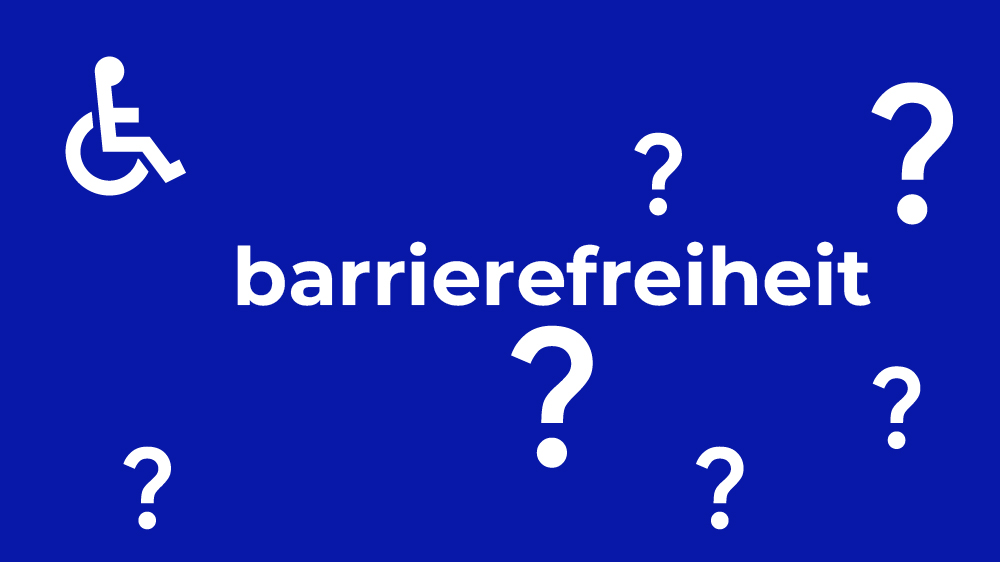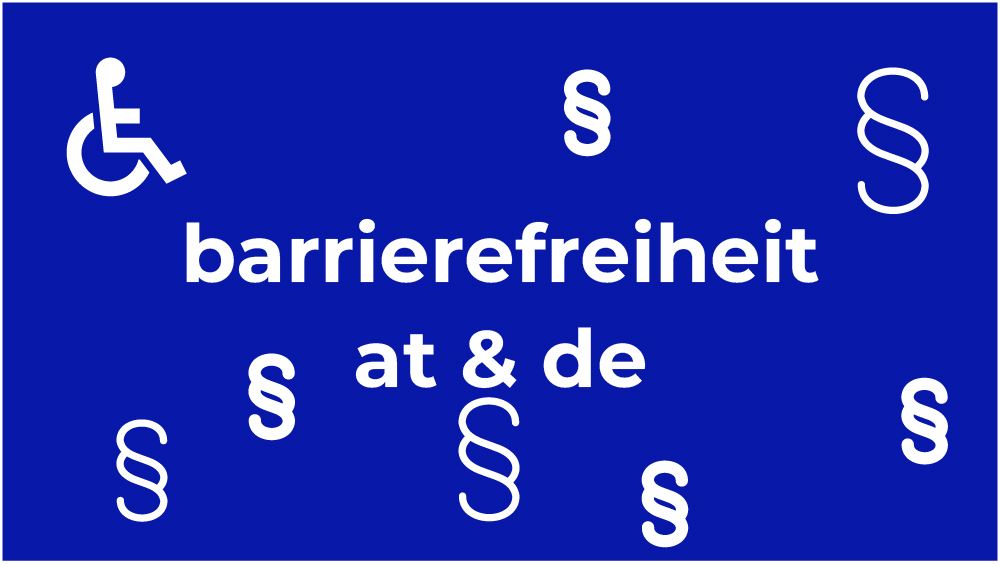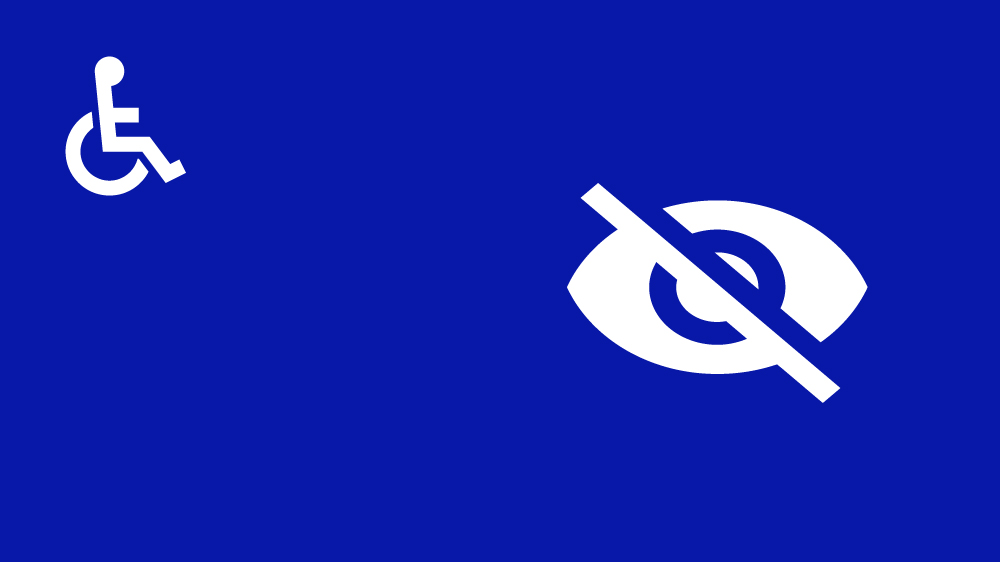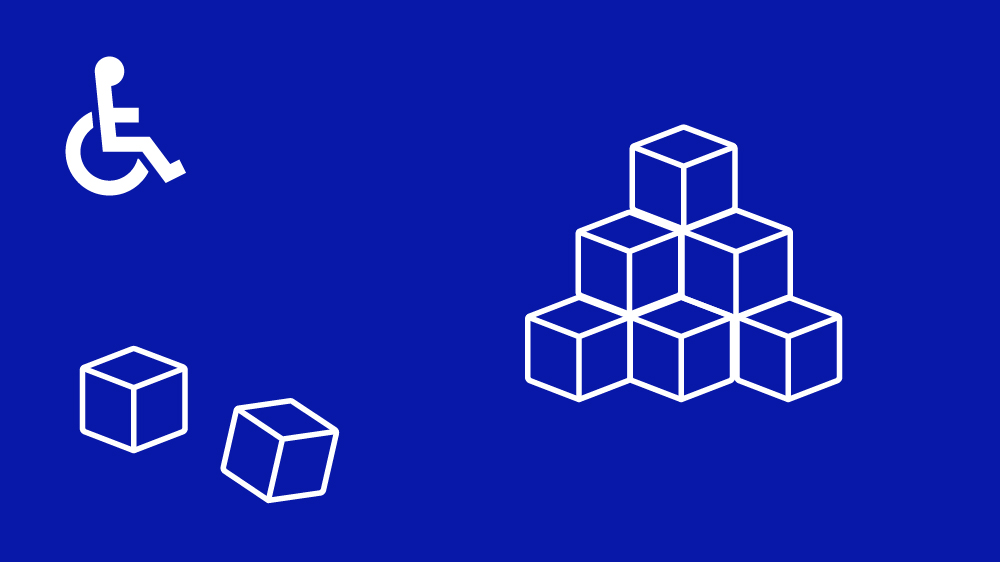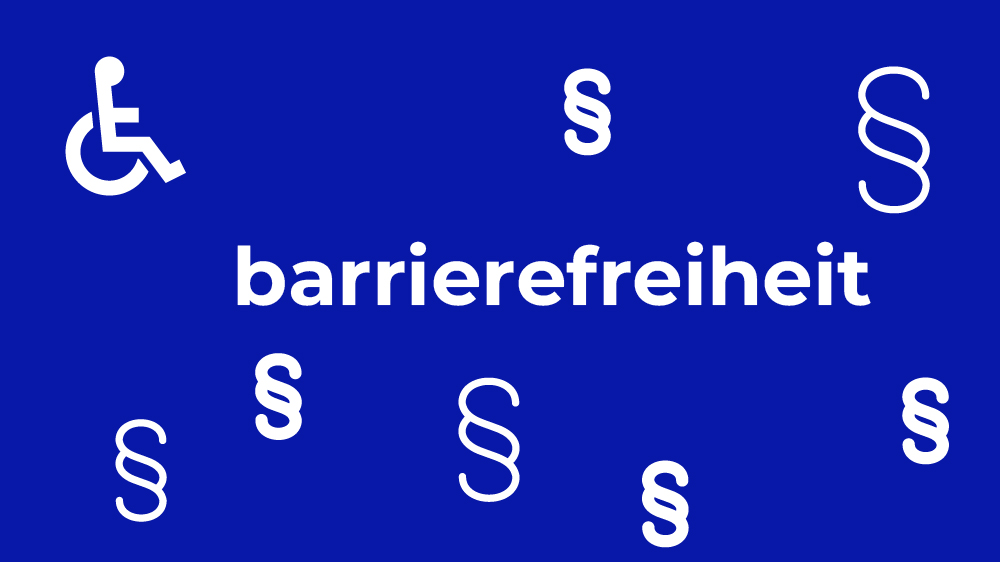What is accessible web design and why is it important? Accessible web design is essential to make the web usable for everyone. But why is it essential for users and website operators? We answer this question in our comprehensive guide to accessible web design. Find out what it means to design accessible websites and what positive effects this has on the user experience as well as on the reach and success of websites.
The most important facts at a glance
Accessible web design is aimed at users with physical, mental and technical disabilities to allow them unrestricted access to web content and follows the guidelines of the Web Accessibility Initiative (WAI) and the Web Content Accessibility Guidelines (WCAG).
Realizing an accessible website is a social responsibility that promotes inclusion, provides unrestricted access to all users and enables companies to expand their target group and achieve economic benefits.
Accessible web design requires continuous adaptation to the WCAG core principles of perceptibility, usability, comprehensibility and robustness so that web content can also be correctly interpreted by assistive technologies.
Basics of accessible web design
Accessible web design aims to ensure that all users, regardless of physical, mental or technical limitations, can access the information and functions of a website without restriction. This means that all content on a website must be designed in such a way that it is accessible and usable for every user - which is exactly what the term "accessibility" embodies.
The implementation of accessible web design enables people with disabilities and other forms of disability to access information and is a key aspect of web accessibility. This includes people with:
Visual impairments
Hearing impairments
motor limitations
cognitive disabilities
on. The aim is to minimize or completely remove barriers so that these user groups can use the Internet in the same way as people without restrictions.
The Web Accessibility Initiative (WAI), which was founded by the W3C in 1997, defines the basic requirements for accessibility on the internet. These requirements form the basis for more complex guidelines such as the Web Content Accessibility Guidelines (WCAG), which are internationally recognized as the standard for accessible web design.
The need for accessibility on the web
Accessible web design is not only an ethical obligation, but also a social responsibility. Companies that develop accessible websites set a positive example and contribute to making the internet usable for everyone. This promotes inclusion and shows that the company is responding to the needs of all user groups.
An accessible website is characterized by an intuitive and easy-to-use user interface that improves usability for all users. This means that people without disabilities also benefit from a well thought-out and well-structured web design. Another argument in favor of accessible web design is the economic component: By providing easy access to online services and products, companies can expand their target group and thus achieve economic benefits.
In an increasingly digital world, web accessibility is essential. It's not just about meeting legal requirements, but also about giving everyone, including people with disabilities, an equal opportunity to use the internet. This includes people with:
Visual impairments
Hearing impairments
motor limitations
cognitive disabilities
in.
Core principles of an accessible website
The Web Content Accessibility Guidelines (WCAG) define four core principles that form the basis for accessible web design:
Perceptibility
Usability
Comprehensibility
Robustness
Perceptibility means that all information and user interfaces are presented in such a way that they can be perceived by every user. This includes measures such as sufficient contrast, alternative texts for images and scalable font sizes. This means that people with visual impairments can also easily grasp the content of a website.
Usability ensures that all control elements are accessible and operable for the user. This means that it must also be possible to navigate the website without a mouse, for example using the keyboard or voice control. This means that people with motor impairments can use the website in the same way as people without these impairments.
Comprehensibility means that the information and operation of the user interface must be clear and understandable. This includes the use of simple language, clear instructions and a logical structure of the content. This also enables people with cognitive impairments to use the website.
Robustness means that content must be designed to be robust enough to be reliably interpreted by a wide range of user agents, including assistive technologies. This ensures that the website remains accessible in the future and on different devices and platforms.
Recognizing and understanding barriers
To design an accessible website, it is important to recognize and understand the different types of barriers that users with disabilities may experience. For example, people with visual impairments need websites that display information with high contrast, provide appropriately sized text and descriptive alternative text for images.
For users with reduced physical mobility, websites should offer easily accessible, clickable elements and have keyboard or voice-controlled navigation capabilities. This enables these users to operate the website without a mouse and still access all functions.
Audio content should alternatively be offered in text form to accommodate people with hearing impairments. This includes subtitles for videos and transcripts for audio content so that these user groups can also use the information. In addition, screen readers can help to make the text accessible to people with visual impairments.
Cognitive barriers should also be taken into account in web design by simplifying the content structure and providing clear instructions. Technical barriers, such as the requirement of a specific browser or its version, the use of Javascript, Flash and long loading times, should be avoided in order to increase accessibility.
Legal framework in Austria
In Austria, there are several laws that regulate accessibility in the public and private sectors. The Federal Disability Equality Act (BGStG) defines the framework conditions for accessibility in the area of federal administration and access to public goods and services. According to the Web Accessibility Act (WZG), the Republic of Austria must make its websites and mobile applications accessible in accordance with international accessibility standards.
The Accessibility Act (BaFG) also sets requirements for accessibility in the private sector, particularly in e-commerce. Companies are required to design their websites in accordance with the definitions of accessibility in Section 6 (5) of the Accessibility Act in order to ensure independent use by people with disabilities. Persons affected by discrimination can assert claims for damages under civil law and must go through a conciliation procedure before filing a lawsuit.
WCAG 2.1 defines the minimum accessibility requirements that are relevant for websites and mobile applications. Associations have the option of filing class action lawsuits against large corporations for the omission or elimination of discrimination in connection with accessibility.
Technologies for greater accessibility
There are various techniques that can be used to improve the accessibility of a website. Sufficient contrast on websites is essential to ensure that all content can be seen clearly. This is particularly important for people with visual impairments. An alternative in the form of an HTML table can facilitate the use of diagrams and infographics.
The website should be completely usable without a mouse and navigation should be consistent. This can be achieved by using clear links, navigability using the tab key and visible highlighting during selection.
Correct hierarchy and structuring with HTML5 tags and the provision of descriptive alt texts for images help to ensure that web content can be correctly interpreted by screen readers. The following measures should be taken to avoid technical barriers:
Restrictions due to specific browsers should be avoided
The use of JavaScript and Flash should be minimized
Optimum loading speed should be ensured.
Design strategies for all user groups
An accessible web design must adapt to the needs of all user groups. This includes adaptation to mobile devices, which offers an improved user experience for all user groups. Websites can offer functions that allow users to activate accessibility extensions and thus have equal access to all functions and features of the website.
The use of plain language with simple words and short sentences can reduce barriers for users with cognitive impairments and language difficulties. This is supported by clear instructions and a logical structure of the content.
Integrating accessibility into the development process of web projects can facilitate interaction and networking for a broad user base.
Case studies: Successful accessible websites
Some companies have already successfully implemented accessible websites and show what accessible web design can look like in practice. Swisscom, for example, worked with Mimacom to develop e-services that take into account digital solutions such as invoicing and web reporting.
Eurowings has created an accessible website with features such as a controllable slider that meet WCAG requirements. Wise developed a global and inclusive design system with a focus on an accessible color system.
These examples show how accessible website features facilitate access to digital content and enable users to use it efficiently. They also highlight how companies can use accessible web design to improve their image and make their services accessible to a wider user base.
Accessibility as part of the development process
Integrating accessibility into the development process of a website is crucial to ensure that all users, regardless of any limitations, can fully utilize web offerings. This requires the interaction of:
Website content
User agents
assistive technology
the capabilities of the users
the expertise of developers/editors
specific authoring software
Evaluation tools.
A collaborative approach, where accessibility is made all-encompassing, requires cooperation at different levels: top-down, from the center outwards and from the bottom up. This promotes inclusion and ensures that accessibility remains an integral part of the development process.
By integrating accessibility into the development process at an early stage, accessibility problems can be identified and rectified during the planning phase. This not only saves time and money, but also improves the user experience for everyone.
Tools and resources for web designers
There are various tools and resources that support web designers in checking and optimizing the accessibility of their websites. Lighthouse, a tool within the Chrome Developer Tools, performs accessibility tests and provides web designers with direct feedback on the accessibility of the tested website.
Siteimprove is an automated testing tool that helps web designers to check compliance with the Web Content Accessibility Guidelines and offers suggestions for optimization. Using the WAVE toolbar developed by WebAIM.org, web designers can record and analyze accessibility problems of a website directly in their browser via an icon display.
Measuring and testing accessibility
A combination of manual tests and automated tools can be used to assess the accessibility of a website. Contrast checker tools help determine whether a website has sufficient contrast between foreground and background colors to accommodate users with color vision deficiencies.
Grammar, spelling and style analysis tools can be used to check the accessibility of website language in order to make texts simple and clear for readers with reading impairments. Both automated testing and user testing with people who rely on assistive technologies are part of the work process to identify and address accessibility barriers.
Accessibility as an ongoing obligation
Accessible web design is not a one-off task, but an ongoing commitment. Constant monitoring and updating of websites is necessary to identify and address accessibility issues as they arise. This requires ongoing commitment and a willingness to carry out regular reviews and make adjustments.
Retrofitting content to support accessibility can be time-consuming, which is a challenge to implement. However, it is a necessary investment to ensure that all user groups can participate equally in digital life. Concerns about the time and cost involved should not be used as an excuse to neglect the implementation of accessibility.
Advantages for companies and organizations
Accessible web design brings numerous advantages for companies and organizations. It enables access for diverse user groups such as people with disabilities, older people or non-native speakers, which expands the target group of a website and thus increases customer satisfaction. By implementing accessible web design, a company underlines its social responsibility and can improve its image and gain a competitive advantage.
Accessible websites are characterized by high technical standards, which contributes to better compatibility, fast loading times and lower traffic costs. User-friendliness is further enhanced by ease of use and good orientation. Adapting to the guidelines for accessible websites can also lead to increased awareness through presence in presentations and rewards from search engines, which improves the findability of the website.
Integrating accessibility into SEO and marketing
Accessible web design and SEO go hand in hand. Valid code that complies with accessibility guidelines allows search engine crawlers to index content more easily and completely, which can lead to better search engine rankings. The use of semantic code and clear structuring in accessible websites promotes search engine optimization.
Accessibility in web design is not only an ethical obligation, but also a decisive factor for a successful SEO strategy that improves the digital visibility of companies. User-friendliness, an important ranking factor for search engines, is easily supported by accessible web design.
Accessible websites that are linked to a positive user experience (UX) can lead to a competitive advantage in SEO. An accessible website improves the user experience for all visitors and can lead to higher engagement and better ranking in search results. The use of alternative text descriptions for images, well-structured headings and links, and a fast website load time helps both users and search engines to find and understand content better.
Summary
Accessible web design is an essential part of the digital world, ensuring that everyone can access the internet without restriction. From the basics and necessity, to the core principles and recognition of barriers, to the legal framework and technical strategies, we have highlighted the most important aspects. Successful case studies show that accessible websites are not only ethically and legally necessary, but also offer numerous benefits for companies and organizations.
The integration of accessibility into the development process and the continuous monitoring and adaptation of websites are essential in order to create an inclusive digital world. Companies that implement accessible web design benefit from an expanded target group, an improved image and better findability in search engines. Let's work together to make the internet accessible for all.
Frequently asked questions
What is accessible web design?** **?
Accessible web design is designed to ensure that all users, regardless of limitations, can access information and functions on a website. It aims to provide unrestricted access for all users.
Why is web accessibility important?** **?
Web accessibility is important because it promotes inclusion, improves usability and provides economic benefits by expanding the target audience. Therefore, it is crucial to ensure web accessibility.
What are the core principles of accessible web design?** **?
The core principles for accessible web design are perceptibility, usability, comprehensibility and robustness in accordance with the WCAG 2.1 guidelines. These principles are crucial to creating an accessible online environment.
What is the legal framework for accessibility in Austria?** **?
In Austria, laws such as the BGStG, WZG and BaFG regulate accessibility in the public and private sectors and define requirements for accessible websites. These laws create a legal framework for accessibility in Austria.
How can accessibility improve SEO and marketing?** **?
Accessibility allows search engine crawlers to index content more easily and completely, leading to better search engine rankings. This can improve the visibility and marketing of your website.
